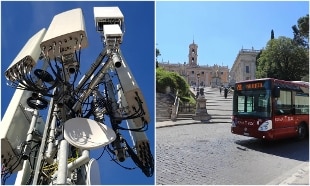- Simplification decree: mayors cannot ban or limit 5G
- 5G, appeal to the Government: it's time to accelerate
Share
23 July 2020 The # Roma5G project takes a leap forward with a new experiment in the field of urban mobility and public safety: the first 5G connected bus in the city and some application scenarios The result of the collaboration between Atac, Fstweb and Ericsson, was presented during a remote press conference. By covering the fifth generation network, it was possible to develop cutting-edge applications capable of significantly improving the efficiency and reliability of public transport.To guarantee the safety of passengers, a video surveillance platform has been created to monitor and report danger situations in real time. On board the car, three latest generation video cameras have been installed for the transmission of high definition images to the Atac control center which, thanks to the use of artificial intelligence, analyzes them in real time to report critical situations inside the buses , such as the presence of weapons, unattended luggage or panic scenes among passengers. This use scenario can also be used to collect data on the flow of passengers in the vehicle, but also to counteract the so-called free riding and evasion. In addition, the driver's cabin is equipped with an emergency button connected to the cloud which, if activated, launches an alarm to the control center, signaling the vehicle's GPS position.
The solution of real time telemetry and predictive maintenance consists instead of an on-board diagnostic system connected directly to the CAN-bus, the system that connects the different electrical control units of the car, with which it is possible to monitor the health status and livability of the vehicle to carry out any repairs in a predictive perspective. The sensors of the system are also able to detect and report in real time the exceeding of a series of parameters, including the pressure and direction of the engine, the actual speed and consumption, or the temperature and humidity level at the interior of the bus.
As part of the experimentation, a system for intelligent traffic management was also developed with the possibility of prioritizing public transport. Thanks to the integration with the urban traffic light management system, the system allows you to regulate the passage of public transport at intersections by reconfiguring traffic lights to ensure green light for buses with the advantage of increasing speed and reducing travel times. This functionality can then also be used for other types of vehicles, for example for emergency vehicles and law enforcement.
For the development of the new digital services, an integrated platform was created by Fastweb and Ericsson that uses the 5G 26Ghz frequencies consisting of two cells, located on a building in Via Prati Fiscali, capable of covering the entire route taken by the bus. s within the testing perimeter. The two antennas, connected to Fastweb's fiber optic transport network, transmit to Ericsson's IoT platform which collects all the data and video images from the bus in real time. The terminal that receives the 5G signal was installed directly on the bus and connected to a router that allowed to aggregate the various network components for the realization of the different use cases.
During the press conference an app for smartphones was also shown, created to facilitate the travel experience of the citizens of Rome Capital during the experimentation, which allows you to receive useful information on incoming lines thanks to the automatic recognition of the stop, to know the estimated waiting time based on real traffic conditions, the number of people on board and free places on the car, and to request an assisted stop.
Among the many areas in which 5G will bring significant innovations, there is that of urban mobility and security: to demonstrate the potential of the fifth generation networks in this sector, Fastweb and Ericsson have collaborated with Atac, the transport company of the Municipality of Rome, developing some use cases that, thanks to technology, can improve the quality and reliability of public transport, meeting the needs of users and citizens of Roma Capitale. Here is a demo of the possible scenarios:

